Karachi’s housing debate: The gilded cage or the gutter
At NED University's 9th annual seminar the experts go head to head with DHA City

ILLUSTRATION: TALHA KHAN
“Inviting DHA City, a gated community, to present at a conference on ‘Housing for All’ is like inviting Big Tobacco to a lung cancer conference,” he said in so many words.
Of course, he prefaced his comment, during a panel discussion, with the gentle reminder that universities are a space for critical inquiry. He was indirectly asserting that he had a right to present his point of view at the event. Indeed, he wasn’t the only one who thought it was problematic that DHA City was also partly sponsoring the conference, and at the end, its project director, Brig. Muhammad Abdullah, announced Rs500,000 for the university.
But it is precisely because the conference was on ‘housing for all’ that Prof. Noman Ahmed, the chairman of the NED department of architecture and planning, had invited DHA City Karachi (DCK). Associate Professor Fariha Amjad Ubaid had supported the idea. Let DHA City present its case. Let its managers, former army men, answer questions from the academic experts and defend their decisions, possibly learning a few things along the way.
As DHA City’s lead consultant engineer Arif Osmani of Osmani & Co pointed out in their defense: “This seminar is about ‘Housing for All’ but it should have then been called housing for the poor. Even the rich need housing.” Where else would such debate take place, if not at a university forum? Let the future architects and planners in the audience learn from the interaction. And as far as the DHA sponsorship is concerned, banners around the auditorium clearly announced the relationship, which is still better than the surreptitious backdoor advertising deals that another real estate entity tends to prefer.
[infogram url=" " height="350"]
And so, the heavy-voiced DHA administrator, Brig. (r) Muhammad Abdullah, and DCK project director Brig. (r) Muhammad Rafique separately came up to the podium to talk about this sprawling new estate. It is located on the Super Highway on 20,000 acres at a site that appears to be a natural choice given that the city is expanding east. It is about 2.5 times the size of the current DHA, they said in gravelly tones. You could tell they were pleased to be presenting at a conference.
The DHA representatives each proudly reiterated that the master plan took a record 12 months to prepare, by 2011. They were perhaps unaware that this was unlikely to impress their audience, made up of academics — men and women who value slow, steady, sweeping and painful cartographies of society instead.
DHA City’s choice of master planners is also interesting. It was undertaken by a consortium of the Pakistani Osmani & Co Ltd, UK-based architects and planners RMJM, Harvard Professor of Design Spiro Pollalis and the Greek Doxiadis Associates. Doxiadis is a familiar name in Pakistan’s planning circles. Aside from planning Islamabad, his firm is responsible for the 1958 Greater Karachi Resettlement Plan that bombed by 1964. The idea had been to clear the inner city slums and move their residents to new townships outside Karachi in Korangi and New Karachi. But as factories and industry didn’t develop there fast enough, the people just returned to squat on land closer to jobs.
The DHA City representatives explained how over 100 international brains were involved in planning the gated community and one of their top priorities was making it self-sufficient in terms of energy and water, which is commendable by any standards.
The DHA reps said they hoped that DCK would be known as the country’s first ever green and smart city, replete with wind and solar energy, for which international certification is being sought. It will have what its designers call all the needs of life from golf courses to medical city complexes to universities. Customers are enticed with the vision of a walled city with three levels of security.
[infogram url=" " height="170"]
Unfortunately, there wasn’t enough time at the conference to examine in depth the smart city elements or renewable energy and water sources of DCK. The conversation veered towards the plot sizes, which actually helped go to the heart of the matter: gated communities versus slums. Certain forces are shaping housing in Karachi; what does this mean for our society? Indeed, as the keynote speaker, Prof. Yap Koie Sheng of Cardiff University said at the start of the conference: “Are we really improving housing or just building houses and forgetting who occupies them?”
DCK is spread over 20,000 acres and has 80,000 plots. This fact opened the floor to the first point of critical inquiry, from Tasneem Siddiqui, a former bureaucrat who worked in pro-poor housing after retirement and is most famous for Khuda ki Basti, a success story now being replicated in Lahore and Islamabad.
Siddiqui wanted to know if DCK had set aside plots for the poor. “How can you expect people who make Rs10,000 a month to buy a plot that costs Rs1,000,000?” he asked. In response, DHA’s Brig. Rafique and Arif Osmani explained that they have set plot sizes from 200 square yards to 2,000. Six thousand plots have been kept aside for the poor and DHA’s own staff of 5,000 people (peons, guards) have all been given titles. “They are people whose salaries are, say Rs15,000 a month,” said Rafique. And for the ‘middle-class’ client, there is the choice of a 500 sq yard plot worth Rs2 million that they can pay over 10 years.
But for Tasneem Siddiqui this was not the end of the dilemma but precisely the symptom of a grander malaise. “You are launching a scheme in a city where 55% of people live in slums,” he argued. “There has to be a balance because land is a very precious commodity. It is not only for rich housing. It is a social asset.”
[infogram url=" " height="420"]
This is the crux of the Karachi’s crisis: the lack of balance in deciding who gets land where. In fact, Siddiqui pointed out that in the mid-1980s they estimated that there were 300,000 vacant plots in Sindh (probably priced out of the average person’s reach). What a waste, when people are forced to live in slums. The rich buy up land and it lies vacant, its value creeping up. This is called speculation, which incidentally Brig. Rafique seemed to support theoretically. He gave the example of how DHA land has grown in value. “In the early 1970s, people bought land for Rs3,000 per square yard but now you can’t find one square yard of commercial space for Rs300,000.”
And so, when Arif Osmani argued that “even the rich need housing” one could ask how he makes that assumption. Do they “need” housing or “want” such large plots. If you check the density of existing upper class housing, they don’t “need” more housing. Existing space could be used better. It’s just that they can afford it.
Haris Gazdar breaks down the question of need. He says that in public policy “need” is defined in terms of minimal requirements. “It is accepted that everyone needs enough to eat,” he told The Express Tribune after the conference. “This is why, when there is a disaster, the government provides relief to affected people. [But] to say that rich people ‘need’ housing is a bit strange.”
People need housing — which housing they get depends on their wealth. “To say that rich people ‘need’ to live on 2,000 sq yards is a bit like saying that I feel my food needs are unmet just because I cannot have champagne and caviar every day.”
[infogram url=" " height="350"]
Housing is thus, very much, a moral problem for people such as Tasneem Siddiqui, Haris Gazdar and the Perween Rahmans of the world. Who should get land in Karachi and how? Should it be the people who can afford it? These questions are important because they explain why we have slums or unofficial regularized settlements and gated communities.
Haris Gazdar says you can either approach housing the market way or argue about public policy (what the government should do). Everyone needs housing. In a pure market economy they go about acquiring it from the market. “The elite in Pakistan claim to be great fans of the market principle,” he said. “They say that slum dwellers etc. are illegal encroachers who violate the market by taking over possession of land which, legally, is not owned by them.” But what the elite refuse acknowledge is that elite housing is heavily subsidized by the government through planning and regulation – by converting government or private land into commercial or residential use by the elite, and by allotting this land to the privileged at throwaway prices.
This much was proved in a 1991 study by David E. Dowall, a professor of city and regional planning at the University of California, Berkeley, who looked at how the Karachi Development Authority priced its land. He showed it was around 25 to 33 percent of market value. Similarly DHA allotments are even more subsidized — around 15 to 20 percent of market price, according to Military Inc. author Ayesha Siddiqa. “What is legal and illegal is, of course, determined by government,” adds Gazdar. “And the regularization of poor peoples’ housing is no different in principle to the land conversions and allotments to the elite. The latter simply happens at a much more massive scale.”
[infogram url=" " height="440"]
There is a constant tension between regulation and regularization. Regulation, according to Gazdar, refers to the “implementation of zoning laws, eviction of existing unplanned settlements and the prevention of new unplanned settlements taking shape”. Regularisation, on the other hand, is the post hoc legalisation of existing unplanned settlements.
Regularisation, then, is the process by which unplanned settlements, sometimes called katchi abadies, are given official status. It is a retrospective action for previously unauthorised development. The katchi abadi is then, in many cases, called a colony. The people get title to the land and the city government then has to incorporate it into its service delivery.
People who arrive in the city become part of the economy and society, make an important contribution – even if they live in slums. “If you take Karachi, about half of it lives in nullahs or on slopes that were left out of the formal urban planning which was for the elite or middle classes,” says Gazdar. “It was on flat land. Low-lying areas and high rise areas were left over and that is where the working class came to live. And they are the ones who built the city.” Informality is a function of inequality in the country as a whole.
[infogram url=" " height="260"]
Karachi has perhaps one of the longest histories of regularization in South Asia, going back to the early 1970s. “Karachi is a place where on the whole, in general, it decides through its very messy politics, in a more humane way, in the favour of regularization. That’s the ethos of Karachi. It is pro-migrant. Let more people come, join.” The opposite is a place where a city is about aesthetics only — at the expense of being an inclusive space.
Non-inclusive visions of a city, ones that do not take as their bedrock the concept of ‘right to the city’ are ultimately unsustainable models. As Tasneem Siddiqi said: “There have been attempts to develop Karachi as a world class city, but this means a city without slums. It should be a city without the poor.” But the reality is that every elite neighbourhood has a slum close by. And perhaps they will spring up around DHA City Karachi too.
View DHA's PowerPoint presentation here.
View an overview of KDA's Housing Schemes in Karachi Urban Design Unit here.

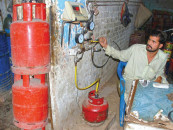
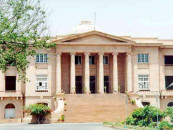
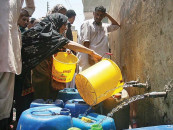
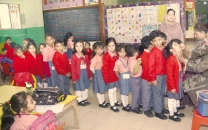

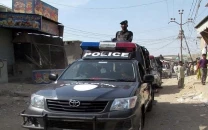












COMMENTS
Comments are moderated and generally will be posted if they are on-topic and not abusive.
For more information, please see our Comments FAQ